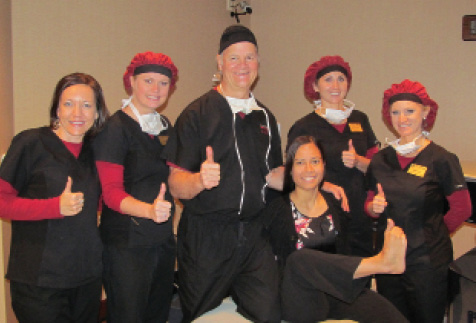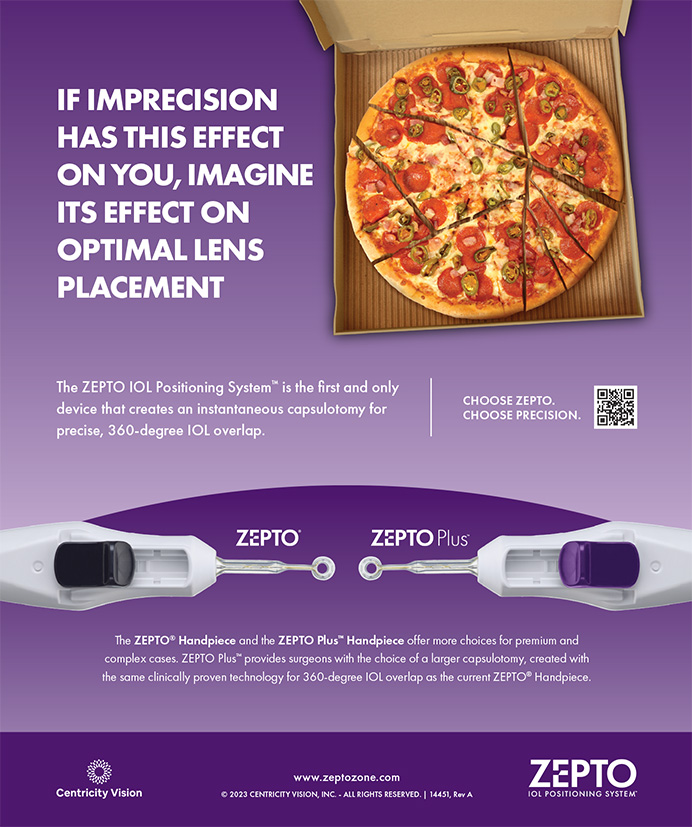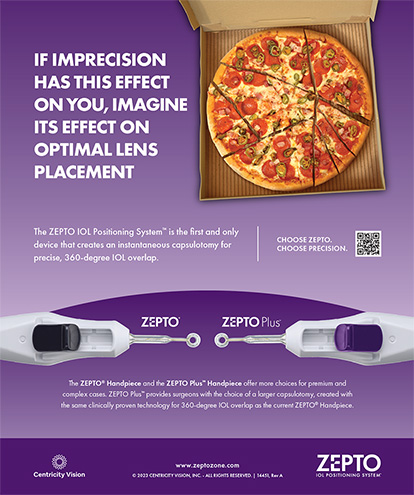
The career of Daniel S. Durrie, MD, has paralleled the evolution of refractive surgery. Dr. Durrie started out performing corneal, cataract, glaucoma, and refractive surgery in the late 1970s, and a little more than a decade later, he was one of the trailblazers committed exclusively to refractive surgery. LASIK’s popularity ebbed and flowed with changes in the economy. While others diversified to gird themselves against fiscal fluctuations, like a true pioneer, Dr. Durrie did the opposite. He immersed himself in the development and improvement of every refractive initiative that emerged. Now, he and his partners Jason E. Stahl, MD, and Timothy P. Lindquist, MD, can market Durrie Vision, the Overland Park, Kansas, practice that Dr. Durrie founded in 2001, as a “true refractive surgery” practice and can tout their expertise in the seven refractive procedures available today.
Another marker that Dr. Durrie says differentiates his practice from the vast majority is that it accepts no insurance; it is a 100% private-pay provider. He estimates that, so far, only about 1% of ophthalmic surgery practices have taken this step, and he maintains that, in his case, the move has paid off. “We don’t have to worry about Obamacare or changes in the insurance system,” says Dr. Durrie. “We try to just provide a high-quality, valuable service to our patients. If they’re happy, they send their friends, and our business keeps growing. We’re satisfied with the direction we’ve taken. We have very low turnover, and we’ve had continued growth and profitability over the years.”
Eschewing insurance and focusing on refractive surgery are the primary factors that elevate Durrie Vision to the status of industry leader. Other contributing factors that complement the winning business model include avoiding comanagement and employing a professional management team led by CEO Harry Campbell. All of these efforts help the practice fulfill its patient-focused credo: vision for life.
In this article, Drs. Durrie and Stahl discuss the importance of the motto and how they plan to expand their “lifetime vision exam” strategy to manage the needs of a heretofore underserved patient population. Mr. Campbell discusses a strategy that boosts employees’ morale, resulting in increased retention and reduced training.
DANIEL S. DURRIE, MD
When you refer to Durrie Vision as a “true” refractive surgery practice, what do you mean?
Ours is not a LASIK practice. There are now seven procedures that a refractive surgeon should understand, master, and develop if [he or she] is going to [have a] true refractive surgery practice—LASIK, PRK, refractive lens exchange, phakic IOLs, corneal inlays, SMILE [small-incision lenticule extraction], and [corneal collagen] cross-linking. People often look at LASIK volume on its own and say that refractive surgery is flat, but the growth of refractive surgery overall is not flat, because there are these six other procedures. The growth of refractive surgery overall has been continuous, but if you just focus on one of the seven procedures, it doesn’t reflect total industry growth. I think it’s important to convey that it is possible to have a thriving practice that is exclusively dedicated to refractive surgery, if it’s understood that refractive surgery is so much more than LASIK. There are so many more things that we can do to expand the services for patients to have better vision without glasses and contacts.
What milestones have brought you and Durrie Vision to where you are today?
The first real milestone was when I made the decision to focus exclusively on refractive surgery. Before that, I was doing glaucoma, cataracts, corneal transplants, and refractive surgery. In 1991, I felt the field was maturing: we were starting clinical trials on excimer lasers, and I could see the direction in which it was going. Since that point, my practice has been focused on refractive surgery.

Durrie Vision’s doctors (from left ): Kelly F. Grosdidier, OD; Daniel S. Durrie, MD; Jason E. Stahl, MD; Suzanne R. LaKamp, OD; and Timothy P. Lindquist, MD.
The next big milestone was in 2005, when we decided to no longer accept private insurance or Medicare and focus instead on being a 100% private-pay practice. It’s easy to see how the focus on refractive surgery and the private-pay model go together, because refractive surgery is not a covered service. The decision to move to a private-pay model was controversial at the time, but it worked out perfectly for us.
How does the credo “vision for life” apply to your treatment strategy and practice growth?
The reason I decided to go to a private-pay model is because the practice was growing and Dr. Stahl had joined the practice. We started looking at the milestones of vision development, and the motto developed out of that. The first milestone is when the eye stops growing, which is usually in patients’ early 20s. At that point in time, they are candidates for laser eye surgery, which we specialized in and had done so much research and development [on]. However, we were also noticing there was a second milestone, which was, essentially, presbyopia, and presbyopia wasn’t addressed much back in 2005. The patients on whom we’d already performed refractive surgery were aging and starting to question why they needed reading glasses as they got older. We started noticing that a lot of patients didn’t have good education about the process, so we focused our practice on not only the first milestone of vision development, which is the maturity and nearsightedness, astigmatism, and farsightedness, but also … on the 45- to 65-year-old[s] and their presbyopia.

Postsurgery “thumbs up” with Focus on Independence patient Jessica Cox. She was born with no arms, so she gave a “toe up.” Ms. Cox has learned to do everything with her feet, including flying a plane!
The third milestone in vision development is a cataract. We certainly have patients who come to us for that, but in many cases, we’re preventing cataracts because we’re doing refractive lens exchange in people in their 50s, so they are having the procedure as a refractive one.
We have been focusing on the three major milestones of vision development, and we plan to implement a fourth milestone to focus on the management of pediatric vision in 8- to 10-year-olds very soon.
What other strategies are integral to Durrie Vision’s successful model?
In 2005, we decided not to comanage patients as a major part of our business model. We still accept referrals from ophthalmologists and optometrists—and we get them often—but our goal is not to send them back to somebody else for postoperative care. Prior to making this decision, we surveyed our patients and learned that they preferred to do follow-up with us. We concluded that, as we take them through the milestones of vision, it made a lot more sense for us to [observe] our own patients. Unless somebody is [from] out of town or has some other reason that [he or she] can’t come back to us for care, both our patients and our practice prefer we see our own patients. Dr. Lindquist did a fellowship with us several years ago, Dr. Stahl did a fellowship with me 16 years ago, and we all do the same thing. We are refractive surgeons, so we interrefer. We share the care of our patients, because [ours is] a practice that is focused on the same thing. It is so gratifying to have good-quality people who all train together and have the same goals and objectives.

Durrie Vision’s business team (from left): Courtney Moilanen, director of marketing; Eileen Alsbrooks, CFO; Tammy Crane, COO; and Harry Campbell, CEO.
Is there something in particular about Durrie Vision that you think helps maintain its leadership position in its market?
When we decide to provide a service, for instance corneal [collagen] cross-linking or corneal inlays, we make sure we master it. We don’t take it trivially. We’re not going to do a weekend course and declare ourselves experts. We usually participate in the clinical trials of the techniques that we offer, and we make sure that we stay up-to-date on all of the techniques. We never add something just so we can enhance our business model and generate revenue. When we get involved in something, we make a big effort to jump in with both feet and make sure that it really is something we can do well.
JASON E. STAHL, MD
In addition to gaining a world-class refractive surgery mentor, Dr. Stahl eventually gained a father-in-law and business partner. He married Dr. Durrie’s daughter, Erin D. Stahl, a pediatric corneal surgeon at Children’s Mercy Hospital in Kansas City. Her expertise and insight are helping to inform Durrie Vision’s expanded interest in pediatric vision management.
Durrie Vision is branching out to address 8- to 10-year-old patients as a fourth vision milestone in its vision-for-life strategy. Why?
We have noticed an alarming rate of dry eyes specifically related to [the] loss of meibomian glands in young refractive surgery patients who had worn contact lenses for many years—some from as early as 10 years old. In addition, we frequently see infections in contact lens wearers. We see not only the loss of endothelial cells but also morphological changes that are all related to contact lens wear. These observations contributed to our decision to extend our advanced ocular analysis to children who are starting to consider wearing contact lenses. Among other things, we plan to monitor them to ensure they’re wearing their contact lenses appropriately so that we’re not seeing the changes I previously mentioned. We thought it would be a good idea to expand our care to the younger population. Maybe some of them need to wear glasses until they are mature enough to consider an alternative such as refractive surgery.

Head for the Cure 5K. Durrie Vision runs in support of Team Kris Campbell (CEO Harry Campbell’s wife). Staff from left: Mr. Campbell, Courtney Moilanen, Melissa Emerson, and Brian Thuringer.
How does this expansion play into the vision-for-life motto?
We love to help restore our patients’ vision surgically to the way we wish it had been naturally, and then we want to maintain that vision for a lifetime. That requires us to see a patient every few years for an advanced ocular analysis. We monitor the health of the eye and also look into the future to see if there are any changes occurring that can help us predict what’s ahead. This leads to counseling patients on what they may need as they approach their 40s and 50s with dysfunctional lens changes and further down the road, when they may need lens replacement. This vision-for-life and ocular analysis strategy is great for us, because we develop long-lasting relationships with our patients. Starting that even earlier can only add to that dynamic.

Durrie Vision team event at Top Golf.
Does the pediatric myopia epidemic play a role in expanding services to children?
There’s an epidemic of myopia worldwide. It’s not at as high a level here in the United States as it is in Asia. Nonetheless, it is an epidemic, so there will be more and more children who will be prescribed contact lenses. That’s what concerns me. Children wearing contact lenses may not always follow best practices as far as how long to wear them and how to clean them. That’s why we are interested in trying to help manage them to make sure that they’re doing it as appropriately as possible.

NFL Hall of famer, MVP, and former Kansas City Chiefs quarterback Len Dawson signing a football for Dr. Stahl after the former’s procedure at Durrie Vision.
We’re also open to the opportunity to do some myopia control or myopia management. There’s a lot of work going on internationally, particularly in Asia, on initiatives aimed at slowing down the progression of myopia. If we can keep [patients] at a low to moderate level of myopia rather than [see] them progress to high myopia, we will hopefully significantly reduce the life-long risks associated with high myopia (retinal detachment, myopic degeneration, glaucoma) and will still be able to offer them refractive treatments to improve their visual function. This is a new frontier, and it fits in perfectly with addressing that first vision milestone, which is the need for glasses or contact lenses.
HARRY CAMPBELL
A veteran advertising, marketing, and leadership executive, Mr. Campbell came to Durrie Vision with a diverse background, including years in telecommunications and a brief stint early in his career with retail icon Sam Walton. A “team-first” mentality is among the ideas he has successfully introduced to the practice.
Lots of practices tout their “patient-first” philosophy as the reason for their success. What are the benefits of Durrie Vision’s team-first philosophy?
My 30 years of being an executive have taught me that, if you get the right people in the right jobs and give them the right direction, they’re the ones who will joyfully and professionally take care of the patients. Drs. Durrie, Stahl, and Lindquist have been very supportive, letting me put that into play here. It doesn’t mean patients are less important; it means the team is more important. We gather anonymous results from an annual employee survey, and our upward trajectory just in the past 3 years on things like “the organization cares about me” and “I trust my senior leaders” and “it’s people first” [is] going through the roof. The result isn’t that our business has gotten better; we already had a world-class practice. What has happened is our turnover has gone down, so we have a much calmer practice, and we’re rarely training because the employees know they’re valued, so they’re relaxed and they do their job better.
Focus on Independence
The act of sliding on eyeglasses or inserting contact lenses seem so insignificant, almost an afterthought, to most people. Daniel S. Durrie, MD, realized that, for quadriplegics and others with certain physical impairments, however, these tasks can literally be out of reach. At a time when he was considering ways to give back to the community, Dr. Durrie saw actor Christopher Reeve deliver a televised speech. Mr. Reeve, who was paralyzed at the time, wore eyeglasses, which his wife had to position on his face. Dr. Durrie was inspired. He created Focus on Independence as a way to use his skills to help individuals suffering from paralysis regain some of their independence.
“There are about 70 surgeons worldwide who are using the Focus on Independence name,” says Dr. Durrie. “It is not a formal organization. It’s more like a group of surgeons who have agreed to interrefer around the country and even around the world. To date, more than 100 people at Durrie Vision and more than 1,000 worldwide have benefited from the program that provides no-charge laser vision correction.”
To participate or nominate someone for the program, please contact Dr. Durrie’s practice at (913) 491-3330 or info@durrievision.com.
What are some examples of things that you do to make employees know that they are the practice’s top priority?
Here are three examples, from the seemingly trivial to the highly significant. There was a time when free bottled water was made available to patients but not to employees. Now, bottled water and an array of snacks are available for free to all employees. Seems insignificant, but when employees have daily reminders that they are appreciated, it trickles down to their interactions with patients and each other. Another example of our plan that puts staff first is that we have more fun recognition reward programs where we give out gift cards, and we have more team events. We get together around six times a year as a team and go to a driving range or a sports bar or have trivia night or go bowling. These events happen from roughly 4:00 to 6:30 pm so people can still get home to their family. We don’t want to discourage that. We’re trying to have people interact with each other more frequently outside of work. We’re not asking them to be friends, but we’re asking them to socialize, because it’s much more likely that they’ll enjoy working with someone if they’ve socialized outside of the workplace.
Finally, our team-first attitude has to do with our pay philosophy. We always paid reasonably well, but we didn’t have a strategy in place. Now, our strategy is to pay at the 90% level in our category. That means, if you went out and found every eye practice in town, we’d be at the 90% or higher level—almost higher than anybody else. We believe that, if you’re going to run a high-end practice that has a brand position that is as well-known as Durrie Vision[’s], you really need to pay well. Two years ago, we gathered data from the five-state area, and we now base our hourly pay on those numbers. We never had high turnover, but now it’s even lower. We were losing four to five people a year in a company of 25 to 30 employees. Now, we’re losing one at most.




